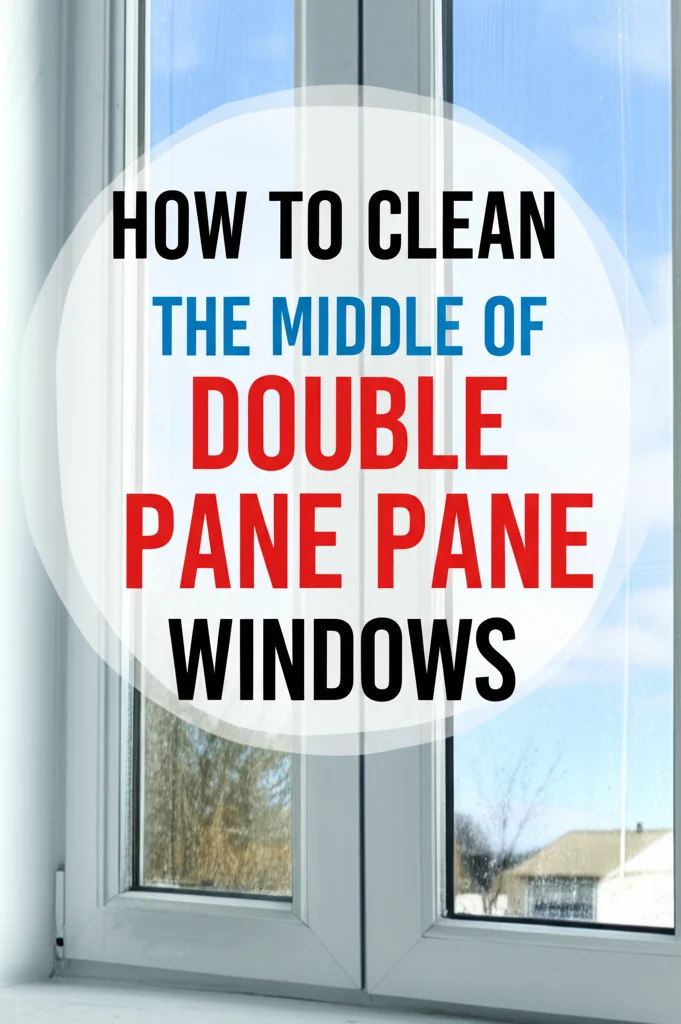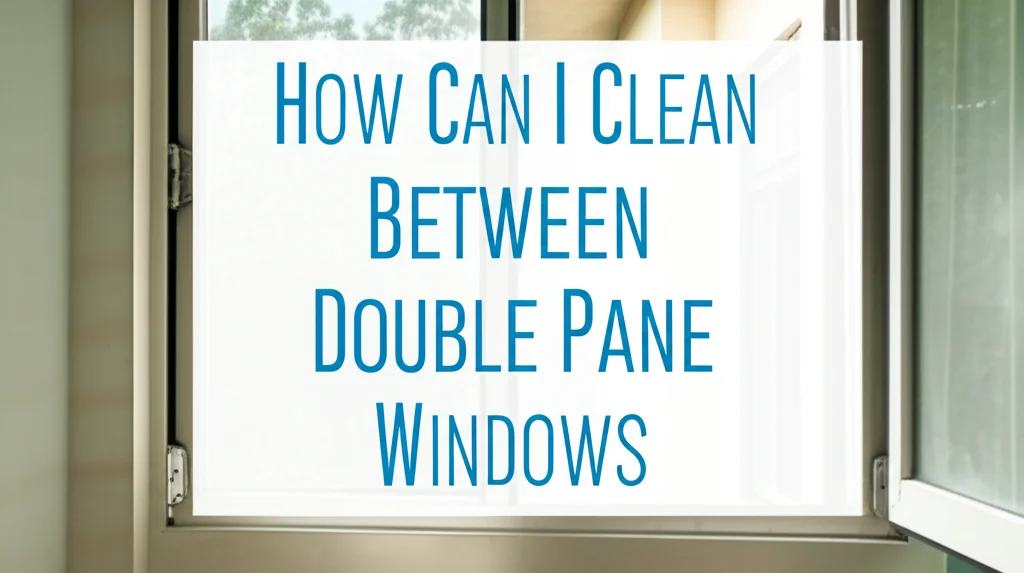· Home Cleaning · 7 min read
How To Clean The Middle Of Double Pane Windows

Cleaning Between the Panes: A Guide to Sparkling Double Pane Windows
Have you noticed a foggy buildup or grime accumulating between the panes of your double-pane windows? It’s a common issue, and thankfully, not always a sign of window failure. Cleaning the space between glass panes can dramatically improve your view and even the energy efficiency of your home. This article will walk you through how to clean the middle of double pane windows, covering everything from identifying the problem to safe and effective cleaning techniques. We’ll explore why this happens, what you can do about it, and when it’s time to call a professional.
Can you actually clean between double pane windows?
Yes, in some cases! If the seal hasn’t completely failed, and there’s a way to introduce cleaning solution, you can often improve the appearance. However, it’s important to understand the limitations and potential risks involved. This guide will help you determine if your windows are suitable for cleaning and provide the safest methods.
Understanding Why Dirt Builds Up Between Panes
Before diving into cleaning, let’s understand why this happens. Double-pane windows are designed to create an insulating barrier. They’re filled with a gas, often argon, to reduce heat transfer. Over time, the seal between the panes can weaken, allowing moisture and dust to enter. This moisture then condenses on the inner surface of the glass, trapping dirt and creating that unsightly foggy appearance.
Here’s a breakdown of common causes:
- Seal Failure: This is the most common culprit. A broken seal allows air and moisture to infiltrate the space between the panes.
- Temperature Fluctuations: Significant temperature changes can cause condensation, even with a good seal.
- Manufacturing Defects: Occasionally, a window may have a minor defect that allows moisture to seep in.
- Age: Over time, all seals degrade, making windows more susceptible to moisture and dirt buildup.
Assessing the Situation: Is Cleaning Possible?
Not all double-pane windows are candidates for cleaning. It’s crucial to assess the situation before attempting anything. If the seal is completely compromised, cleaning will only be a temporary fix. Here’s how to evaluate your windows:
- Condensation: Is the condensation constant, or does it disappear when the temperature changes? Constant condensation indicates a failed seal.
- Visible Damage: Look for cracks or gaps around the window frame or between the panes.
- Access Point: Is there a small weep hole (a tiny hole in the window frame) that might allow you to introduce a cleaning solution? Do not drill new holes.
- Severity of Dirt: Is it a light film of dust, or a thick, stubborn buildup? Severe buildup may be impossible to remove without professional help.
If you suspect a complete seal failure, it’s best to consult a window repair professional. Attempting to clean a severely damaged window could worsen the problem.
The Vinegar and Water Solution: A Gentle Approach
For windows with minor condensation and accessible weep holes, a vinegar and water solution is a safe and effective cleaning method. Vinegar is a natural cleaner and disinfectant, and it won’t damage the glass or seals.
Here’s what you’ll need:
- Distilled white vinegar
- Distilled water
- Spray bottle
- Small funnel (optional)
- Clean microfiber cloths
Instructions:
- Mix the Solution: Combine equal parts distilled white vinegar and distilled water in a spray bottle. Using distilled water prevents mineral deposits.
- Introduce the Solution: Carefully spray the vinegar solution into the weep hole(s) of the window. Don’t overfill; a few sprays per hole are sufficient.
- Tilt and Swirl: Gently tilt the window back and forth to allow the solution to spread between the panes.
- Let it Sit: Allow the solution to sit for 10-15 minutes to loosen the dirt and grime.
- Drain and Wipe: Tilt the window to allow the solution to drain out. Wipe the exterior glass with a clean microfiber cloth.
- Repeat if Necessary: If the condensation persists, repeat the process.
Using Isopropyl Alcohol for Stubborn Residue
If the vinegar and water solution isn’t enough, isopropyl alcohol (rubbing alcohol) can help dissolve stubborn residue. However, use it cautiously, as it can potentially damage some window seals.
Important Considerations:
- Dilution: Dilute the isopropyl alcohol with distilled water (a 1:1 ratio).
- Spot Test: Before applying to the entire window, test the solution on a small, inconspicuous area to ensure it doesn’t damage the seal.
- Ventilation: Work in a well-ventilated area, as isopropyl alcohol fumes can be strong.
Instructions:
- Prepare the Solution: Mix equal parts isopropyl alcohol and distilled water in a spray bottle.
- Apply and Swirl: Follow the same application and swirling steps as with the vinegar solution.
- Drain and Wipe: Allow the solution to drain and wipe the exterior glass clean.
- Monitor: Observe the window for any signs of seal damage after cleaning.
Preventing Future Buildup: Maintaining Clean Windows
Once you’ve cleaned between the panes, taking steps to prevent future buildup is essential. Here are some tips:
- Control Humidity: Maintain a consistent humidity level in your home, especially during colder months. Use a dehumidifier if necessary.
- Proper Ventilation: Ensure adequate ventilation in your home to reduce condensation.
- Regular Exterior Cleaning: Clean the exterior of your windows regularly to remove dirt and grime that can contribute to buildup. You can find more information on exterior window cleaning here.
- Inspect Seals: Periodically inspect the window seals for any signs of damage. Address any issues promptly to prevent further deterioration.
- Consider Window Film: Applying a low-E window film can help reduce heat transfer and condensation.
When to Call a Professional Window Repair Service
Sometimes, cleaning isn’t enough. If you’ve tried the methods above and the condensation persists, or if the seal is visibly damaged, it’s time to call a professional. Here are some signs you need professional help:
- Constant Condensation: Condensation that doesn’t disappear with temperature changes.
- Visible Seal Failure: Cracks or gaps around the window frame or between the panes.
- Extensive Dirt Buildup: A thick, stubborn buildup that you can’t remove.
- Drafts: Feeling a draft near the window.
- Increased Energy Bills: Higher energy bills due to inefficient windows.
A professional can assess the damage and recommend the best course of action, which may include seal repair, glass replacement, or even window replacement.
FAQ: Addressing Common Concerns
Q: Will cleaning between the panes completely eliminate condensation?
A: Not necessarily. Cleaning can improve the appearance, but if the seal is failing, condensation will likely return. It’s a temporary fix for a larger problem.
Q: Is it safe to use other cleaning solutions, like bleach or ammonia?
A: No. Bleach and ammonia can damage the glass and seals, and they can also be harmful to your health. Stick to vinegar and isopropyl alcohol (used cautiously).
Q: How often should I clean between my double-pane windows?
A: It depends on the severity of the buildup. Generally, cleaning once or twice a year is sufficient if you’re proactive about preventing condensation.
Q: Can I inject cleaning solution into the window with a syringe?
A: While possible, it’s risky. You could damage the seal or the glass. Using the existing weep holes is the safest method.
Q: What if my windows don’t have weep holes?
A: If your windows lack weep holes, cleaning between the panes is likely not feasible without professional intervention.
Conclusion: Maintaining Clear Views and Energy Efficiency
Cleaning the middle of double pane windows can be a worthwhile effort, restoring clarity and potentially improving energy efficiency. Remember to assess the situation carefully, use gentle cleaning solutions, and prioritize safety. If you suspect a significant seal failure, don’t hesitate to contact a professional window repair service. By following these tips, you can enjoy clear views and a comfortable home for years to come. Keeping your windows clean, both inside and out, is an investment in your home’s value and your overall well-being. Don’t forget to also consider how you maintain the floors around your windows – a clean home is a happy home! For example, you might want to learn how to clean hardwood floors with vinegar to complete the cleaning process.




